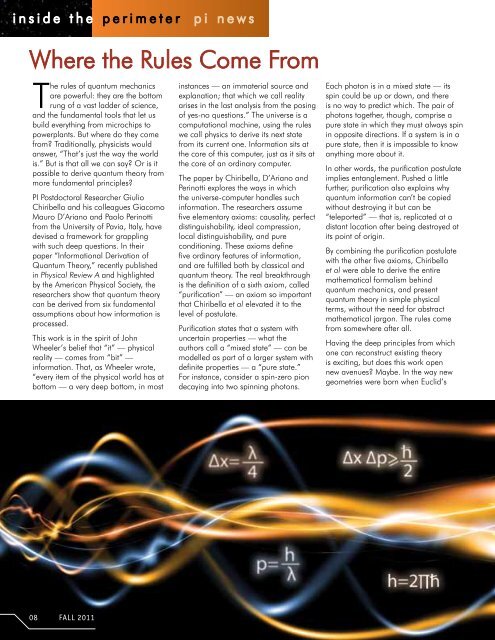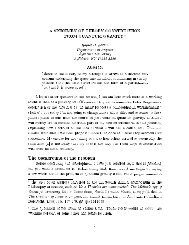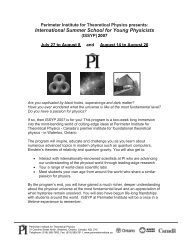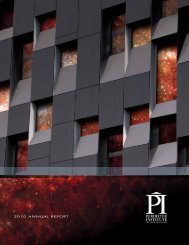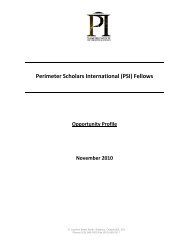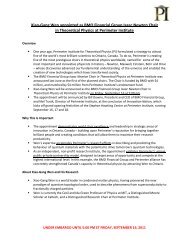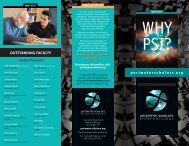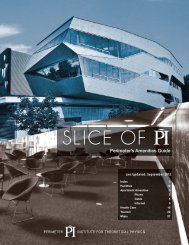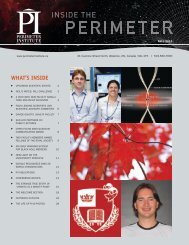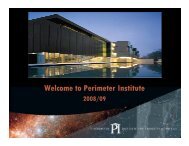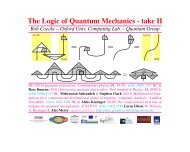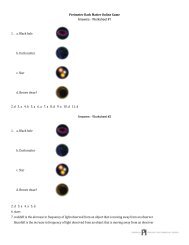i n s i d e t h e p e r i m e t e rp i n e w sWhere the Rules Come FromThe rules of quantum mechanicsare powerful: they are the bottomrung of a vast ladder of science,and the fundamental tools that let usbuild everything from microchips topowerplants. But where do they comefrom? Traditionally, physicists wouldanswer, “That’s just the way the worldis.” But is that all we can say? Or is itpossible to derive quantum theory frommore fundamental principles?PI Postdoctoral Researcher GiulioChiribella and his colleagues GiacomoMauro D’Ariano and Paolo Perinottifrom the University of Pavia, Italy, havedevised a framework for grapplingwith such deep questions. In theirpaper “Informational Derivation ofQuantum Theory,” recently publishedin Physical Review A and highlightedby the American Physical Society, theresearchers show that quantum theorycan be derived from six fundamentalassumptions about how information isprocessed.This work is in the spirit of JohnWheeler’s belief that “it” — physicalreality — comes from “bit” —information. That, as Wheeler wrote,“every item of the physical world has atbottom — a very deep bottom, in mostinstances — an immaterial source andexplanation; that which we call realityarises in the last analysis from the posingof yes-no questions.” The universe is acomputational machine, using the ruleswe call physics to derive its next statefrom its current one. Information sits atthe core of this computer, just as it sits atthe core of an ordinary computer.The paper by Chiribella, D’Ariano andPerinotti explores the ways in whichthe universe-computer handles suchinformation. The researchers assumefive elementary axioms: causality, perfectdistinguishability, ideal compression,local distinguishability, and pureconditioning. These axioms definefive ordinary features of information,and are fulfilled both by classical andquantum theory. The real breakthroughis the definition of a sixth axiom, called“purification” — an axiom so importantthat Chiribella et al elevated it to thelevel of postulate.Purification states that a system withuncertain properties — what theauthors call a “mixed state” — can bemodelled as part of a larger system withdefinite properties — a “pure state.”For instance, consider a spin-zero piondecaying into two spinning photons.Each photon is in a mixed state — itsspin could be up or down, and thereis no way to predict which. The pair ofphotons together, though, comprise apure state in which they must always spinin opposite directions. If a system is in apure state, then it is impossible to knowanything more about it.In other words, the purification postulateimplies entanglement. Pushed a littlefurther, purification also explains whyquantum information can’t be copiedwithout destroying it but can be“teleported” — that is, replicated at adistant location after being destroyed atits point of origin.By combining the purification postulatewith the other five axioms, Chiribellaet al were able to derive the entiremathematical formalism behindquantum mechanics, and presentquantum theory in simple physicalterms, without the need for abstractmathematical jargon. The rules comefrom somewhere after all.Having the deep principles from whichone can reconstruct existing theoryis exciting, but does this work opennew avenues? Maybe. In the way newgeometries were born when Euclid’s08 Fall 2011
fifth postulate was questioned, definingthe postulates of quantum informationgives physicists exact places to zero intheir attention, which could lead to thediscovery of alternative theories.For instance, one of the most radicalchanges to quantum theory would beto drop the assumption of causality:the idea that the future cannot affectthe past. (Or, to put a quantuminformation spin on it, the idea thatinformation propagates in a preferreddirection, identified with “time”.) SeveralElla Secararesearchers at <strong>Perimeter</strong> — includingChiribella and quantum theorist LucienHardy — are developing frameworksthat do not presume underlyingspacetime or fixed causal structures.This may open new doors for mergingquantum theory and general relativity.—Erin BowFurther Exploration:• G. Chiribella, G. M. D’Ariano, P.Perinotti, “Informational Derivationof Quantum Theory”, Phys. Rev. A84, 012311 (2011), http://pra.aps.org/abstract/PRA/v84/i1/e012311• G. Chiribella, G. M. D’Ariano, P.Perinotti, “Probabilistic Theorieswith Purification”, Phys. Rev. A 81,062348 (2010), http://pra.aps.org/abstract/PRA/v81/i6/e062348• C. Brukner, “Questioning the rulesof the game”, Physics 4, 55 (2011),http://physics.aps.org/articles/v4/55• D. Powell, “Quantum Theory getsphysical”, ScienceNews, http://www.sciencenews.org/view/generic/id/332557/title/Quantum_theory_gets_physicalRelated works:• L. Hardy, arXiv/quant-ph/0101012(2001).• B. Dakic and Č. Brukner, in DeepBeauty, edited by Hans Halvorson(Cambridge University Press, NewYork, 2011)• L. Masanes and M. P. Mueller, NewJ. Phys. 13, 063001 (2011).Fair Dice“Not only does God play dice withthe universe,” says Roger Colbeck.“His dice are fair.”Colbeck, a postdoctoral researcher at<strong>Perimeter</strong>, recently published a paperentitled “No extension of quantumtheory can have improved predictivepower,” in Nature Communications.“If quantum theory is correct, thenit is also complete,” says Colbeck.“There cannot be a better descriptionof the outcomes.”The probabilistic nature of quantum predictions troubled many earlyquantum scientists, including Einstein, who famously objected that “Goddoes not play dice with the universe.” In the 1930s, Einstein, Podolsky, andRosen (among others) argued that even if quantum mechanics is a correcttheory, it might not be a complete one: there might be a deeper reality –perhaps hidden variables that if measured could allow scientists to predictoutcomes without quantum uncertainty. This proposition is so famous thatit’s known by its acronym: EPR.In the 1960s, J.S. Bell’s eponymous theorem showed that no local hiddenvariables exist which would take all the uncertainty out of quantummechanics. But can we take out any of it? That’s been a door left ajar forhalf a century.Colbeck – working in collaboration with Renato Renner from ETH Zurichin Switzerland – has closed that door. This new research shows that nouncertainty can be removed.This conclusion is reached partly via a connection to quantumcryptography. Imagine two people, Alice and Bob, trying to establish ashared key that no one else knows, which they might use to send secretmessages to each other. In quantum cryptography, the key might begenerated by first sharing and then measuring a series of entangledparticles. If a “bad guy” sits in between Alice and Bob, the only way he cangain information about the key is by disturbing the entanglement. Hence,Alice and Bob can detect any attempted interception.The intriguing thing, to Colbeck, is that Alice and Bob can generate asecure key without needing to know anything about how the measurementdevices operate. In an extreme case, one might imagine that the bad guysomehow got his hands on the device, and corrupted it as he pleases.Remarkably, this does not present a problem: even if the bad guy designsand supplies the device himself, Alice and Bob can perform tests toestablish that the measurement outcomes are nevertheless secure.That’s called device independence, and to Colbeck, it’s a powerful tool. Itlets you replace “the bad guy” with “the universe.” In this way, the deviceindependentcryptographic result can be used to derive a result in quantumfoundations.In other words: If there were hidden variables, as EPR proposed, then theuniverse could use them to determine what the device would output. Sinceno one and nothing can predict – or even slightly influence – outputs in thisway, then there are no hidden variables, not even weak ones, and quantumpredictions generally cannot be improved.—Erin BowFurther Exploration:“No extension of quantum theory can have improved predictive power,”Roger Colbeck & Renato Renner; Nature Communications, Volume 2,Article 411; 02 August 2011fall 2011 09


